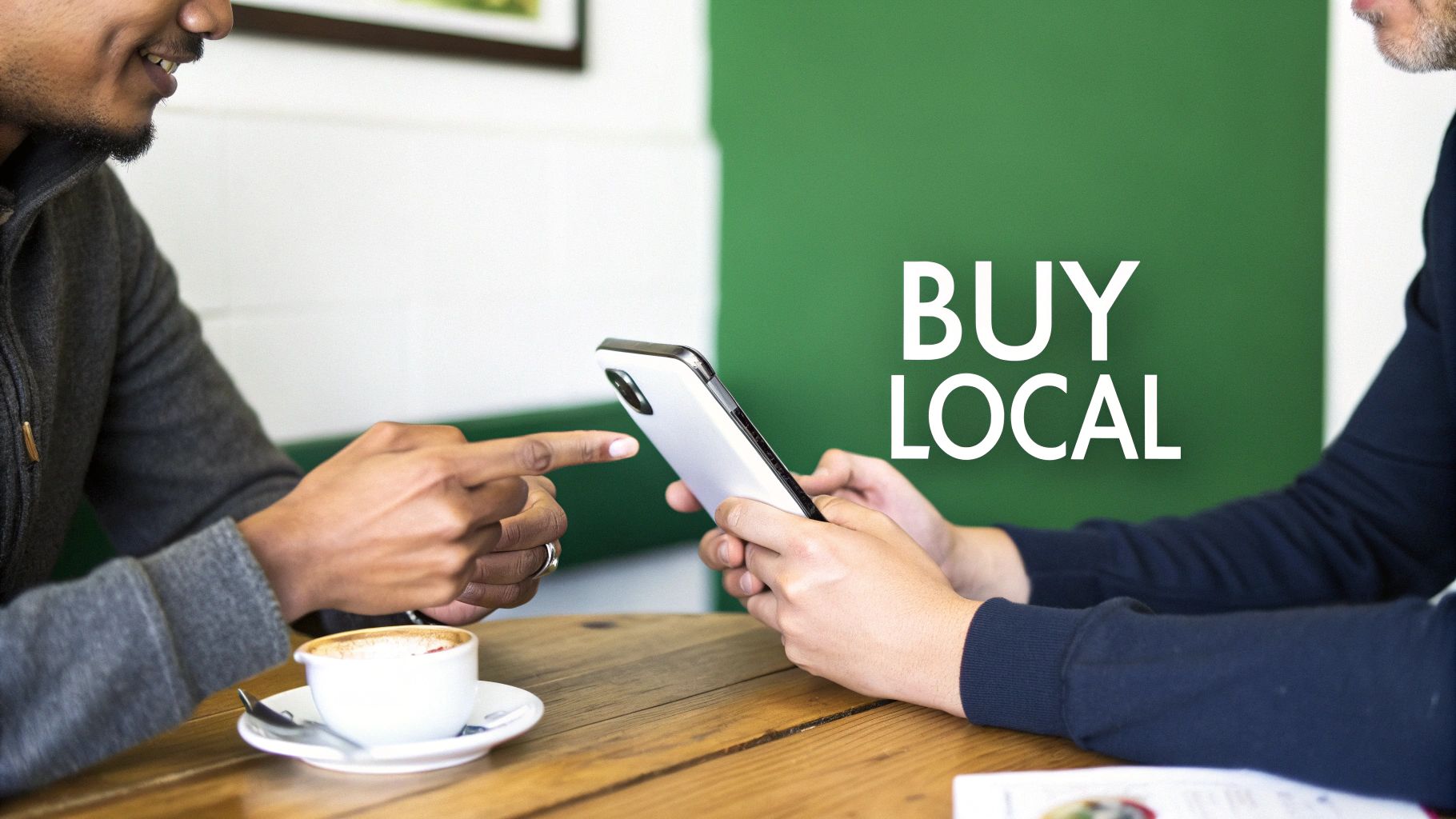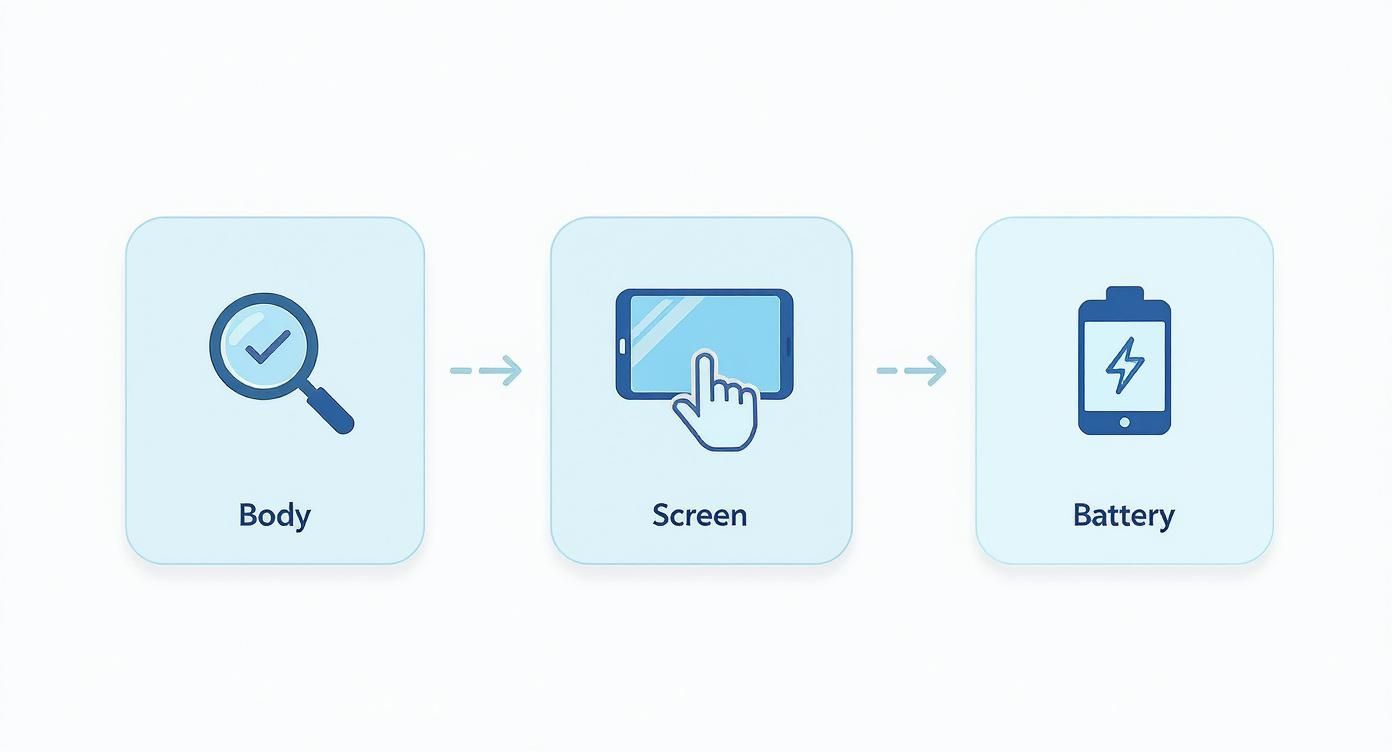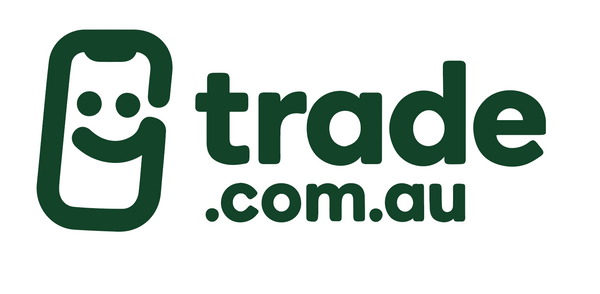
Finding Second Hand Cell Phones Near Me: A Smart Buyer's Guide
Searching for "second hand cell phones near me" isn't just about finding a cheap phone; it's a smart move that saves you cash and puts you in control. When you buy locally from a private seller, you get the massive advantage of actually holding and inspecting the device in person—something you just can't do with online-only sellers. That hands-on check builds confidence and makes sure you know exactly what you’re getting.
But is it the safest way? Let’s explore how to navigate the local market and introduce a smarter alternative.
Why Buying a Used Phone Locally is a Smart Move

Choosing to buy a used phone locally in Australia means you're joining a growing wave of smart, budget-conscious consumers. With the price of new flagship models soaring into the thousands, it’s no wonder people are looking for quality alternatives that don't drain their bank accounts.
This isn't just a hunch. The demand for second-hand and refurbished phones in Australia has genuinely taken off, pushed by rising smartphone costs and people becoming more price-sensitive. It's a clear signal that we're moving towards a more practical and sustainable way of owning tech. If you're curious about the numbers behind this trend, you can read the full research about the Australian used mobile phone market.
The Power of In-Person Inspection
Honestly, the single biggest win of buying locally is getting to physically inspect the phone. You simply can’t spot faint screen scratches, a sticky home button, or a wobbly charging port from a few photos online. Meeting a seller face-to-face lets you do the important stuff:
- Assess its true condition: You can check for all the little cosmetic details—dents, deep scratches, and scuffs—that often don't show up in pictures.
- Test the core functions: Power it on. Test the screen's responsiveness, check the camera quality, and make sure the speakers and microphone work perfectly.
- Verify the battery health: For iPhones, you can dive straight into the settings and check the "Maximum Capacity" percentage. This gives you a crystal-clear picture of its remaining life.
This direct interaction cuts out the guesswork and the risk of getting a phone that looks nothing like its online description.
Buying locally means you confirm the phone’s condition with your own eyes and hands. This simple step is the best defence against disappointment, ensuring you walk away with a purchase you’ll be happy with.
Ultimately, choosing a local deal puts you in the driver’s seat. You get the phone straight away with no shipping delays, you’re supporting someone in your community, and most importantly, you’re making a smart decision based on what you can see and test yourself—not just a seller's word for it.
Where to Find Quality Used Phones in Your Area

So, you're ready to find a great deal on a second-hand phone. Knowing where to look is half the battle. When you search for "second hand cell phones near me," you’ll almost certainly land on popular classifieds like Gumtree and Facebook Marketplace. They’re absolutely packed with listings from private sellers all over Australia.
These platforms are fantastic for getting a feel for what’s available in your suburb, whether you’re in Sydney, Melbourne, or a smaller regional town. Mobile internet usage in Australia has made this whole process incredibly easy. With over 50% of total internet activity now happening on phones, you can compare deals and chat with sellers in an instant. This digital shift has opened up the local second-hand market in a massive way.
Navigating Local Sellers
As you start browsing, you'll quickly notice two main types of sellers: private individuals and professional resellers. Buying from a private person often feels more direct—you’re usually dealing with the phone's original owner, which can sometimes lead to a better price. But it definitely comes with more "buyer beware" responsibility.
Professional resellers, on the other hand, are often local tech repair shops or small businesses. They usually offer a different experience, typically testing their devices and sometimes even providing a short-term warranty. When you're weighing up your options, from local classifieds to broader online platforms, getting a sense of the entire landscape by exploring various industry marketplaces can help you make a more informed decision.
To help you figure out which path is right for you, let's compare the different types of local sellers you're likely to come across.
Comparing Local Second-Hand Phone Sellers
| Seller Type | Pros | Cons | Best For |
|---|---|---|---|
| Private Individual | Often cheaper, potential for negotiation, quick local pickup. | No warranty, higher risk of undisclosed issues, sold "as is". | Bargain hunters who are confident in their inspection skills. |
| Professional Reseller | Phones are often tested, may offer a limited warranty, more accountability. | Slightly higher prices, limited stock compared to large marketplaces. | Buyers wanting a bit more security than a private sale offers. |
At the end of the day, you're weighing up risk versus reward.
A private sale might save you a few dollars upfront, but a reseller or verified marketplace provides a crucial safety net that protects your investment long-term.
There's a smarter, safer alternative that gives you local convenience and guaranteed quality. Platforms like Trade.com.au bridge this gap perfectly. We offer professionally refurbished devices that have passed strict, multi-point checks and come with a solid warranty. You get the value of a second-hand price without the gamble of a private sale.
For a complete rundown, check out our comprehensive guide on how to buy a used phone in Australia.
Your Essential Pre-Purchase Inspection Checklist
Alright, you’ve found a promising second hand phone nearby and set up a time to meet. This is the moment of truth. It's easy to feel rushed or pressured, but a genuine seller will have no problem letting you check the device properly. Think of this checklist as your game plan—it'll help you inspect the phone with confidence.
When you're looking at a used phone, remember its history matters. How it was cared for, and even how it was stored, can seriously affect its lifespan. A good guide to protecting electronics shows just how much proper handling makes a difference, which gives you a better idea of what to look for.
The Physical Once-Over
First things first, give the phone a good look-over in decent light. Sometimes you have to tilt a phone just right to see the faint hairline scratches on the screen or body that you might otherwise miss.
- Check the frame and corners: Look for any dents, dings, or deep scuffs. These are tell-tale signs of a serious drop, which could mean internal damage.
- Inspect the charging port: Get a close look. Is it full of lint and gunk? Does the connection feel loose or wobbly when you plug a cable in? That's a huge red flag.
- Examine camera lenses: Make sure there are no scratches or cracks on the front or back lenses. Even a tiny scratch can ruin your photos.
- Test the buttons: Click every single physical button—power, volume up, volume down, and the mute switch if it’s an iPhone. They should feel clicky and responsive, not sticky or mushy.
Screen and Display Health
The screen is where you'll spend all your time, so it needs to be in top shape. A neat trick is to open a plain white image in a web browser to check for any weird discolouration or yellowing. Then, switch to a black image to spot any bright spots or "dead" pixels that are stuck.
Next up is touch sensitivity. Open a notes app and just scribble all over the screen. If you see any gaps or breaks in your lines, it means you've found an unresponsive spot on the digitiser. For a deeper dive, our complete guide on how to inspect a phone’s condition is a fantastic resource.
Battery Health and Performance
A phone is only as good as its battery. This is one of the most important checks you can do, and luckily, it's pretty straightforward.
For iPhones:
- Head to Settings > Battery > Battery Health & Charging.
- Check the Maximum Capacity percentage. For a used device, anything above 80% is generally a good sign.
For Androids:
This can be a bit more of a mixed bag, as different brands hide this information in different places. Some Samsung phones show battery health in the Samsung Members app. If you can't find it, you can always download a third-party app like AccuBattery to get a reliable estimate.
Don't just trust the percentage on the screen. Actually use the phone for a few minutes. Open some apps, take a photo, browse a website. If the battery drops more than a few percent in that short time, you’re likely looking at a worn-out battery.
Testing Critical Functions
Finally, it’s time to run through the phone’s core features. I always recommend bringing a portable power bank and your own SIM card to do this properly.
- Cameras: Fire up the camera app. Snap a few photos and a short video using both the front and rear cameras. Check for any blurry spots, focus problems, or weird glitches.
- Speakers and Microphone: Play a YouTube video to test the speakers. Then, make a quick call to a friend or record a voice memo to make sure the microphone is working clearly.
- Connectivity: If you're meeting at a cafe, connect to their Wi-Fi. Toggle the Bluetooth on and see if it can find any nearby devices.
- Charging: Plug the phone into your power bank. It should start charging straight away without you needing to wiggle the cable around.
Running through this checklist gives you total confidence in your purchase. It helps you either walk away with a fantastic deal or wisely dodge a lemon.
How to Negotiate and Complete the Sale Safely
Alright, you’ve given the phone a thorough once-over, and it’s ticked all the boxes. Now for the part that can feel a bit awkward: settling on a price and paying up. Don’t sweat it—a friendly, respectful negotiation is a totally normal part of buying second-hand.
If your inspection turned up a few minor things you can live with, now’s the time to mention them. Maybe there are some cosmetic scuffs, or the battery health is hovering just over 80%. This is your chance to be fair but firm.
You could try saying something like, “It’s a great phone, but since the battery will probably need replacing in the next year or so, would you consider knocking $20 off the price?” The goal here is to be reasonable. You're not low-balling; you're using the facts from your inspection to find a fair price for both of you.
Paying Securely and Finalising the Deal
Once you’ve shaken on a price, safety becomes the top priority. Honestly, carrying a big wad of cash around isn’t the best idea—it can make you a target. It’s much smarter to use a digital payment method that gives you both a secure transaction and a clear record.
- PayID: This is a fantastic option in Australia. It’s linked straight to a bank account using just a mobile number or email, and the transfer is instant. The seller gets the money on the spot, so you can both see the transaction go through.
- PayPal: If you go with PayPal, always use the "Goods and Services" option. It costs a small fee, but the buyer protection you get is worth its weight in gold. Some sellers might ask you to use "Friends and Family" to dodge the fee, but you should politely insist on the protected method. It’s for your own peace of mind.
This simple process flow highlights the most crucial areas to check: the phone's physical body, its screen responsiveness, and its battery health.

Running through this sequence ensures you have all the info you need to negotiate with confidence and fairness.
Finalising the purchase safely is just as important as the inspection. Never feel pressured to pay with cash if you're uncomfortable. A legitimate seller will understand the need for a secure, traceable payment.
The Smart Alternative: Why Refurbished Beats Second-Hand
While hunting for "second hand cell phones near me" can sometimes unearth a local gem, going the private route always comes with a big catch: risk. The phone might look perfect on the outside, but you have zero guarantees about its history, battery life, or what happens if it develops a strange glitch a week after you hand over your cash.
This is where certified refurbished devices completely change the game.
Think of it like buying a used car. You could take your chances buying one privately from a stranger's driveway—what you see is what you get, and good luck if the engine light comes on tomorrow. Or, you could buy a certified pre-owned car from a reputable dealer. It’s been professionally inspected, serviced, and comes with a warranty. That second option gives you peace of mind, and the exact same logic applies to buying a phone.
The Refurbished Advantage: Peace of Mind Included
There’s a world of difference between "second-hand" and "certified refurbished." A typical second-hand phone is sold as-is, potential hidden issues and all. A "certified refurbished" phone from a trusted marketplace like Trade.com.au is a different beast entirely.
Every single device goes through a strict, professional process to make sure it meets our high standards. This isn't just a quick wipe-down and polish.
Here's a look at what happens behind the scenes:
- A comprehensive diagnostic check: Our technicians test dozens of functions, from battery health and screen responsiveness to camera quality and port connections. We leave no stone unturned.
- Professional repairs and cleaning: If any components are faulty, they're replaced with high-quality parts. The device is also thoroughly sanitised for its new owner.
- Data wiping and factory reset: The phone is securely wiped of all previous user data, guaranteeing your privacy and giving you that fresh-out-of-the-box experience.
The Australian smartphone market is massive—valued at around AUD 8.58 billion and still climbing. Within that, the demand for affordable, top-quality used phones is surging as people trade in their premium devices more often. This creates a fantastic supply of near-new devices for the refurbished market. If you want the full picture, you can learn more about Australia's smartphone market trends.
Choosing a certified refurbished phone isn't just a safer purchase; it’s a smarter one. You get the value of a second-hand price with the confidence and reliability of a new device, complete with a warranty.
This approach completely removes the guesswork and stress of private sales. You don't have to become a tech expert overnight or worry about negotiating in a car park. Instead, you can browse a curated selection of reliable phones online and have one delivered right to your door.
And if you're looking to offset the cost of your upgrade, our guide on how to trade in your phone for cash shows you just how simple the process can be.
Your Questions Answered: Buying Used Phones Safely
Even with all the right information, we get it—pulling the trigger on a used phone can feel like a big step. It’s completely normal to have a few last-minute questions before you commit. Let’s clear up some of the most common concerns we hear from buyers.
Is It Safe to Meet a Stranger to Buy a Phone?
This is probably the biggest hurdle for anyone looking at a private sale, and for good reason. If you do decide to meet up with a seller from a marketplace, always, always choose a busy, public place. Think of a local cafe during lunchtime, not a quiet car park.
Never go alone. Bring a friend or at least make sure someone knows exactly where you are and when you’re expected back. It’s just smart practice.
Honestly, the best way to sidestep this risk entirely is to buy from a verified business. Platforms like Trade.com.au take the entire meeting-a-stranger part out of the equation. We handle the transaction securely and ship a fully tested device straight to your door. No awkward meetups necessary.
How Do I Know if a Used Phone is Stolen?
A huge, valid concern. The last thing you want is to buy a phone that’s been reported lost or stolen, turning it into a very expensive paperweight.
Before you even agree to meet, ask the seller for the phone's IMEI number. It’s a unique 15-digit code. You can then pop that number into the Australian Mobile Telecommunications Association (AMTA) website for a free check. A legitimate seller won't hesitate to give it to you; if they make excuses, that’s a massive red flag.
What if the Phone Breaks After I Buy It?
In a private sale, you’re almost always on your own. Once you hand over the cash, the deal is done. If a hidden fault pops up a week later, you have virtually no way to get your money back.
This is the single biggest argument for choosing a certified refurbished phone over a straight-up "used" one from a random seller. A warranty is your safety net. It’s what protects you from those unexpected hardware failures that can happen to any device, new or used. It transforms a risky gamble into a smart, protected purchase, giving you peace of mind long after you’ve unboxed it.
Ready to skip the risks of a private sale and find a device you can trust? At Trade.com.au, every phone is professionally inspected, comes with a solid warranty, and is delivered right to your door. Explore our range of certified refurbished tech and find your next phone today. Visit us at https://www.trade.com.au.
